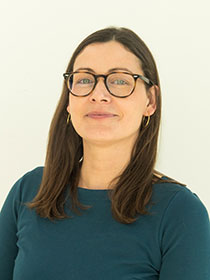Prof. Dr. Andrea Kaifie-Pechmann
Stand: 08.04.2025

Prof. Dr. Andrea Kaifie-Pechmann
STIKO-Tätigkeit
Mitglied seit März 2024
Mitgliedschaft in folgenden Arbeitsgruppen (AG):
- AG Methodik
- AG Pertussis
- AG Reiseimpfungen
Institutionszugehörigkeit
Direktorin des Instituts und der Poliklinik f. Arbeits-, Sozial- und Umweltmedizin und Leiterin der Betriebsärztlichen Dienststelle
Friedrich-Alexander-Universität
Medizinische Fakultät
Institut und Poliklinik für Arbeits-, Sozial- und Umweltmedizin
Henkestraße 9 u. 11
91054 Erlangen
Arbeitsschwerpunkte in der Impfprävention
- Infektionsgefährdungen am Arbeitsplatz
- Beruflich relevante Impfungen
- Berufliches Reisen
Beruflicher Werdegang
- seit 10/2023 Direktorin des Instituts und der Poliklinik für Arbeits-, Sozial- und Umweltmedizin der Friedrich-Alexander-Universität Erlangen-Nürnberg
- seit 10/2023 Leiterin der betriebsärztlichen Dienststelle der Friedrich-Alexander-Universität Erlangen-Nürnberg
- 03/2021 Venia legendi für das Fach Arbeits-, Sozial- und Umweltmedizin
- 03/2021 Fachärztin für Arbeitsmedizin
- 08/2015 Master of Science in Public Health (Epidemiologie und Prävention), Heinrich-Heine-Universität Düsseldorf
- 03/2014 Fachärztin für Allgemeinmedizin
Selbstauskunft
Interessenskonflikte, die den Anschein der Befangenheit begründen:
Keine
Ausgewählte Publikationen
- Kaifie, A., et al., Contamination pathways of polychlorinated biphenyls (PCBs) - From the worker to the family. Int J Hyg Environ Health, 2019. 222(8): p. 1109-1114.
- Kaifie, A., et al., Informal e-waste recycling and plasma levels of non-dioxin-like polychlorinated biphenyls (NDL-PCBs) - A cross-sectional study at Agbogbloshie, Ghana. Sci Total Environ, 2020. 723: p. 138073.
- Knaup, T., Esser, A. Schettgen, T., Kraus, T., Kaifie, A., Which factors influence the frequency of participation in longitudinal cohort studies? - An analysis of demographics, social factors, and medical preconditions in participants of the health effects in high level exposure to polychlorinated biphenyls (HELPcB) cohort. J Toxicol Environ Health A, 2021. 84(23): p. 973-985.
- Kaifie, A., et al., Environmental release of non-Aroclor polychlorinated biphenyls by a silicone rubber production site did not lead to elevated plasma levels in the nearby population. Int J Hyg Environ Health, 2022. 245: p. 114028.
- Wiesehahn, L.T. and Kaifie, A., The impact of the 2021 flood on the outpatient care in the North Rhine region, Germany: a cross-sectional study. BMC Public Health, 2024. 24(1): p. 250.
